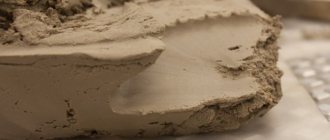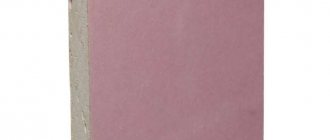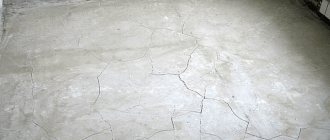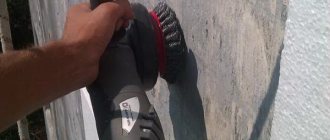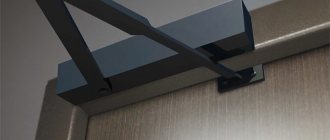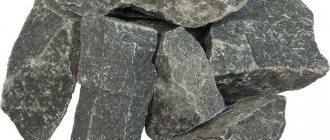Clay, properties, types and varieties, origin, extraction and use.
Clay is a sedimentary rock with a fine-grained structure and complex composition. Plasticity, viscosity, fire resistance and other properties of clay are determined by which rock-forming substance is the main one.
Clay
Characteristics and properties of clay. “Fat” and “skinny” clays. Color. Water resistance. Plastic. Fire resistance. Caking ability
Types and varieties of clay
Origin of clay
Clay mining. Quarrying methods
Application and use of clay. Advantages
Clay:
Clay is a sedimentary rock with a fine-grained structure and complex composition. Plasticity, viscosity, fire resistance and other properties of clay are determined by which rock-forming substance is the main one.
These can be clay materials such as kaolinite (Al2O3 2SiO2 2H2O), andalusite, disthene and sillimanite (Al2O3 SiO2), montmorillonite (MgO Al2O3 3SiO2 1.5H2O), halloysite (Al2O3 SiO2 H2O), hydrargillite (Al2O3 3H2O), diaspore (Al2O3 H2O), corundum (Al2O3), monothermite (0.2[K2MgCa]O Al2O3 2SiO2 1.5H2O), muscovite (K2O Al2O3 6SiO2 2H2O), nacrite (Al2O3·SiO2·2H2O) and pyrophyllite (Al2O3·4SiO2·H2O).
For example, montmorillonite, which belongs to layered silicates, has sorption properties and has a pronounced ability to swell strongly.
Different types of clay may contain particles of kaolinite, andalusite, muscovite, hydrargillite, nacrite, corundum, pyrophyllite and other constituent minerals in different proportions.
Among the impurities, the most common particles are quartz, gypsum, calcium, dolomite, pyrite, siderite, magnetite, and glauconite.
Characteristics and properties of clay:
The characteristics of clay materials depend on their composition, granule size, moisture content of the material, and location of extraction. When assessing the properties of clay, a whole range of characteristics is used - from density and solubility in water to porosity and thermal conductivity.
Main properties of clay:
– when it gets into water, it gets wet and breaks up into separate particles, forming a suspension or forms a mass similar to dough;
– in a dry state it has the structure of dust, in a wet state it becomes soft, plastic, and easily takes any shape;
– after drying or firing, it becomes strong and durable. As it dries, it decreases slightly in volume due to natural shrinkage;
– when moistened, it has good binding abilities. Thanks to these qualities, it is used in the manufacture of bricks and some types of dishes;
– clay in a wet state has good covering qualities, so in the past it was often used for coating wood-burning stoves, walls of houses and outbuildings;
– this material is capable of absorbing substances dissolved in liquids. Sorption properties make it possible to use it for filtration and purification from foreign impurities of vegetable fats and petroleum products.
Technologies for processing clay , changing its composition or “fat content” make it possible to obtain raw materials with specified properties - the desired shade, with greater fire resistance, less shrinkage, etc.
The properties of clays used in ceramic technology can be combined into four main groups: water-based, mechanical, drying and firing (thermal).The water properties of clays manifest themselves when they interact freely with water. To understand them, it is necessary to consider the “clay-water” system.
Water is a homogeneous medium, and water molecules are electrically neutral. But the water surrounding the grain of a clay particle has different properties, since its molecules acquire a dipole structure, and its ends acquire a charge.
Since grains of clay minerals are always negatively charged due to the substitution of cations in the crystal lattice or the presence of dangling uncompensated bonds at its ends, water is oriented towards the clay particles by positively charged dipoles. Monomolecular layer of water 2 forms tightly bound water, which has special properties: lower liquefaction and freezing point, higher density. This water forms a single whole with the clay - a micelle. As you move away from the surface of the grain, the strength of the force field and the intensity of attraction of water molecules decreases. Water molecules, under the influence of a weaker field, already have some freedom of movement. They form a diffuse layer 4, in which the water is loosely bound . A grain of clay mineral is surrounded by several concentric layers of water, each of which is held by the particle with a force that decreases from its surface to the periphery. This scheme is valid for pure water without impurities. In real conditions, water in clay always contains salts, the molecules of which dissociate into ions. The cations of these salts, being carriers of positive charges, are surrounded by their “own” water shell and, together with it, are in a diffuse layer or are adsorbed on the surface of the clay-forming mineral grain, creating a so-called sorbed complex. This structure of the water shell explains many of the properties of clays, including water properties: moisture capacity, swelling, soakability and thixotropy.
Water holding capacity is the ability of clay to absorb and retain water through the forces of molecular attraction, osmotic absorption and capillary forces. The latter are small compared to molecular forces, so osmotic and capillary water form free water groups. The moisture capacity of clay depends on its dispersion and mineralogical composition: with increasing dispersion and specific surface area, it increases. Montmorillonite clays have a higher moisture capacity than kaolinite clays.
Swelling is the ability of clay to increase volume by absorbing moisture from the air or when it comes into contact with water. Quantitatively, the degree of swelling according to GOST 3594.12-92 is measured by the increase in the volume of absorbed moisture relative to the mass of clay. A clay particle is an aggregate of coherent primary grains of clay minerals, often cemented with natural cationic cements. Swelling of clays occurs due to the fact that polarized water molecules wedge between individual clay aggregates and, adsorbed on their surface, push them apart, creating a water shell around them, and penetrate into the space between the individual layers of the lattice, forming interlayer water. The degree of swelling depends on the dispersion and mineralogical composition of the clays. Dispersed montmorillonite clays give the greatest swelling, kaolinite clays the least. The structure of the kaolinite crystal lattice packet is such that one end is represented by the H+ ion, and the other by OH-. Therefore, the ends of the two packets are firmly connected to each other by oppositely charged ions, and water molecules cannot move such a lattice apart; they are only adsorbed on its surface. Montmorillonite has a symmetrical crystal lattice structure: the oxygen charges at the ends of the packets close together, creating a weak bond. Therefore, water molecules easily wedge into the interpacket space of the lattice, pushing it apart. The sandiness of clays reduces swelling. In this case, contraction occurs: the volume of swollen clay is less than the sum of the volumes of clay and water, due to compression of the clay and increased density. The process fades over time. Loose clays swell faster than dense clays.
Soaking is the disintegration of aggregated clay particles in water into smaller particles or elementary grains with the formation of a polydisperse system. The nature of the strength of clays is explained by several factors. One of them is the forces of secondary valences (van der Waals forces), i.e. the forces of intermolecular attraction. They arise due to the polarization of molecules and dispersion interaction, in which the movement of electrons in molecules leads to the appearance of instantaneous dipoles and mutual attraction. The first stage of clay dispersion is swelling, when water molecules, drawn into the spaces between the grains of the aggregate, wedge them. As the thickness of the water shell increases, it increasingly screens the action of cohesive forces, weakening the connection between individual grains. With sufficiently thick water shells, their outer layers are connected not by forces of intermolecular attraction, but by capillary pressure inside relatively large pores, if they are not completely filled with water. In this case, capillary pressure forces pull together the individual grains of the particle, preventing them from completely separating. When the pores are filled with water, the menisci disappear and the action of capillary pressure forces ceases. After this, the grains easily move in the water, being suspended in it, which means the clay is completely soaked. The soaking process begins from the surface of the clay piece. Its swollen outer layers, experiencing shear stress, gradually separate, exposing new surfaces for interaction with water. However, in dense clays, separation of such layers almost does not occur, and their hydration makes it difficult for water to enter the inner layers of the piece. Therefore, dense clays are difficult to soak. Stirring the clay speeds up the process by mechanically breaking down the particles and exposing new surfaces for soaking. Heating water also speeds up soaking, due to a decrease in its viscosity when heated. It is easier to absorb. The intensity of soaking is important for the uniformity of plastic dough and slips.
Thixotropic hardening is the ability of a wet clay mass to spontaneously restore its damaged structure and strengthen at constant humidity.
At the initial time t0, the clay mass has a strength R0sd. Over time, its strength increases, reaching the value R'sd by time t1. At this moment, the structure is forcibly destroyed (for example, the slip is loosened), and its strength drops to its initial strength. After this, by time t2 it is again restored to Rсд'. After secondary destruction during settling, it again restores strength, etc. Self-strengthening of clay occurs due to the orientation of clay and water particles with opposite charges, which increases the strength of their adhesion. In this case, the process of transition of part of the water from free forms to bound forms occurs due to deeper hydration of clay grains. The intensity and magnitude of thixotropic hardening depends on the exposure time. The shear resistance of clay dough increases 1 day after processing by 2.4 times, after 3.5 – by 2.6, after 22 – by 3.1, after 120 – by 5.4, after 240 days – by 7, 9 times. Thixotropy reduces the casting properties of slips.
The mechanical properties of clays manifest themselves when they are exposed to external forces. The most important of them is plasticity. Plasticity is the ability of clay, under the influence of external forces, to take any shape without breaking the continuity and retain it after the force ceases. Plasticity is one of the states of clays, which is different from brittle and viscous-flowing. The brittle state is characterized by the fact that the sample is destroyed upon rupture without changing the cross-section and after this the system is not restored. In a viscous-fluid state, the mixture spreads under the influence of its own mass. The plastic state is intermediate between brittle and viscous-flowing. In a completely dry state, a clay sample has quite high strength and breaks brittlely. With a slight increase in humidity, the strength of the sample first drops sharply, due to adsorption wedging by the absorbed moisture, but the brittle state remains. According to P.A. Rebinder, one monomolecular layer of adsorbed water reduces the strength of clay by 1000 times. A further increase in humidity leads to a slower decrease in strength. If the water shells are large enough to allow the particles to slide against each other when exposed to external forces, a plastic state is achieved. At the same time, water, by forces of surface tension, pulls together clay particles, preventing them from spreading, and provides significant shear mobility of clay particles, giving them the ability to slide. A further increase in the moisture content of the clay leads to such an increase in the thickness of the water shells that they completely screen the action of the forces of intermolecular attraction and exclude the action of capillary pressure. In this regard, the strength of the system decreases so much that it cannot withstand the action of its own mass and acquires a viscous-fluid state. According to GOST 21216.1-93, the measure of plasticity is the plasticity number P, %, calculated by the formula:
П = wт – wр ,% (2.8)
where wт and wр – humidity at the yield point and at the rolling limit.
The moisture content of the rolling limit (wр) is the boundary between the brittle and plastic states of the system, and the moisture content of the yield strength (wт) separates the region of the plastic state from the viscous-fluid state. The physical meaning of the plasticity index is linked to the mechanism of the essence of the plastic state: it determines the humidity range in which the clay retains its plastic state. According to the plasticity number, GOST divides clays into five groups: highly plastic (P > 25), medium plastic (P = 15...25), moderately plastic (P = 7...15), low plastic (P < 7) and non-plastic, not giving plastic dough. The plasticity of clays depends on their granulometric and mineralogical composition: with increasing dispersion, plasticity increases. Montmorillonite clays are the most plastic, kaolinite clays are the least plastic. Sandiness of clays reduces their plasticity . Molding moisture content, or water demand, is also an important indicator of the water properties of clays. It is achieved when the clay is shaped by the human hand and does not stick to the hands or to the metal. The average pressing force of a human hand corresponds to approximately 0.2 MPa, and the ultimate shear stress at molding moisture content is approximately 0.06 MPa. Molding humidity depends on the composition of the clay: with increasing sand content it decreases, and with increasing dispersity it increases; for montmorillonite clays it is higher than for kaolinite clays.
The relationship between molding moisture content wf and the content of clay substance Ag, wt. % is expressed by the dependence:
w f = K Agl, (2)
where K is an experimental coefficient having the following values:
Agl,% 6-7 8-10 10-12 20-30 30-40 40-50 50-60
K 3.2 2.2 1.5 1.0 0.8 0.6 0.5
Clay must be molded at a humidity level that provides the greatest plasticity. The extensibility of clays is the maximum relative elongation at which the sample breaks. The amount of elongation determines the crack resistance of ceramic products during drying. The drying properties of clays reflect the changes that occur in the clay mass when it is dried. These include: air shrinkage, sensitivity to drying and moisture conductivity. Air shrinkage is a reduction in the size of a clay sample during drying and is one of the important drying properties of clay. Shrinkage deformations in clay during drying are caused by capillary pressure forces, and shrinkage occurs due to a violation of the force balance in the capillary.
The measure of shrinkage phenomena in drying is the value of relative shrinkage:
Lfrom = (l0 – l1)/ l0, (3)
where Lo is the relative shrinkage, %, l0 and l1 are the initial and final length of the sample. Relative air shrinkage, depending on the plasticity of the clay, is in the range of 2...8%. The sand content of clays reduces air shrinkage. Montmorillonite clays exhibit the greatest shrinkage, kaolinite clays the least. In addition to the composition and properties of clays, the amount of shrinkage is also affected by the drying mode: with slow drying (for example, natural), the shrinkage is greater than with a harsh artificial drying mode. For the same clay, the amount of air shrinkage depends on the initial moisture content of the sample. For the same value of l1, the sample can have different lengths lк.у. depending on its initial moisture content w0 (Fig. 6), and this, as can be seen from (3), will also change the amount of shrinkage. Therefore, the amount of air shrinkage in isolation from the moisture content of the sample is not a physical constant characterizing the shrinkage phenomena of a given clay. The dependence of the sample length on its moisture content in the shrinkage range, as can be seen from Fig. 6 is described by a straight line. Its slope does not depend on the initial moisture content, but only on the grain composition of a given clay. Therefore, it can be used as an indicator characterizing shrinkage properties.
The angular coefficient of this straight line is called the shrinkage coefficient Kus, which can be considered as a physical constant that characterizes the shrinkage properties of a given clay. Kus is calculated using the formula:
Kus = tan α = (l0–lк.у.) / (w0–wк.у.) (4)
where lк.у. and wk.u. – respectively, the length and moisture content of the sample at the end of shrinkage.
The hydraulic conductivity of clays reflects the intensity of moisture movement within the clay mass. A quantitative indicator characterizing this property is the moisture transfer potential coefficient a' , called the potential conductivity coefficient in drying theory. For different clays it ranges from (0.66...2.14) x 10 m2/h.
There is a close relationship between the hydraulic conductivity of clay and its composition. It increases with a decrease in the content of the clay fraction, since only they bind water with their force field, limiting the freedom of its movement. Montmorillonite clays have a hydraulic conductivity that is 10...15 times less than kaolinite clays, since montmorillonite binds water most strongly due to the peculiarities of its structure. Hydraulic conductivity depends on the temperature of the clay mass, increasing in proportion to the fourteenth power of absolute temperature, and on the initial moisture content of the clay, increasing with its increase. This is explained by a decrease in the intensity of the connection of moisture with the material as the thickness of the hydration shells increases.
The sensitivity of clays to drying characterizes their crack resistance in this process. The cause of cracks is the unequal amount of shrinkage across the cross-section of the product, which is why stress arises in it. When their value exceeds the tensile strength of the raw material, cracks form. The indicator of crack resistance in drying clays is the coefficient of sensitivity of clays to drying Kch
(5)
where V0 and G0 are the volume and mass of the wet sample after molding, respectively; V, G – the same for the sample dried to constant weight.
In its physical meaning, this indicator expresses the relationship between the volume of shrinkage and the volume of pores in the sample. According to the value of CN, clays are of three classes: low-sensitive (CN < 1), medium-sensitive (CN = 1...1.5) and highly sensitive (CN > 1.5).
An increase in the strength of clays contributes to an increase in crack resistance. The strength of clay increases with increasing content of the clay fraction in it. Therefore, the addition of highly plastic clay to lean clay often helps to reduce product defects during drying. Montmorillonite clays provide raw material strength higher than kaolinite clays. However, there is no close connection between the strength of clays and their crack resistance in drying, but such a connection exists between tensile strength and crack resistance. With an increase in the shrinkage coefficient, the crack resistance of clays decreases, and with an increase in hydraulic conductivity, it increases. This explains the lower sensitivity of sandy clays compared to “fat” clays with a high content of the clay fraction. But the presence of fine sand (slough) in the clay, which greatly thins the clay, reducing shrinkage, reduces strength and elongation, without increasing the hydraulic conductivity of the clay, since the pores in the ceramics are small with high hydrodynamic resistance. Therefore, such clays, having a low Cn, are crack-resistant and highly sensitive to drying. Thus, the crack resistance of ceramics during drying is jointly influenced by the strength, elongation, shrinkage and hydraulic conductivity of clay.
The thermal (firing) properties of clays are manifested in the process of heating the clay at high temperatures. The most important of them are fire resistance, fire shrinkage, sinterability and firing interval.
Fire resistance is the ability of ceramic materials and products to withstand high temperatures without melting. An indicator of fire resistance is the temperature at which a sample of a material having the shape of a triangular truncated pyramid (commonly called a “cone”) deforms from its own gravity and touches the top of the ceramic stand. The fire resistance of clay is defined as its conventional melting point. This temperature is conditional because the clay rock is polydisperse and does not have a strictly defined melting point, but melts in a certain temperature range. Therefore, the melting point of clay is taken to be its fire resistance. According to GOST 9169, clays are divided into three classes according to fire resistance: fireproof - fire resistance above 1580°C, refractory 1350...1580°C and low-melting - below 1350°C. The refractoriness of clay depends on its chemical composition: alumina (Al2O3) increases the refractoriness of clay, fine-grained silica (SiO2) reduces it, and coarse-grained silica increases the refractoriness. Alkali metal impurities (R2O) are the most powerful fluxes - substances that lower the melting point of clay. Alkaline earth metal oxides (RO) are also fluxes, but at a higher temperature than alkali metals. The refractoriness of ceramics containing iron oxides depends on the type of gas environment during firing: a reducing environment reduces refractoriness, since Fe2O3 is reduced to FeO, with high reactivity. It forms fayalite (2FeO SiO2) with SiO2, which has a melting point of 1205°C and plays the role of a flux.
Sinterability is the second important thermal property of clays. By sintering we mean the ability to be compacted during firing to form a solid stone-like body. Sintering of clays occurs due to the contraction and gluing of solid particles by the liquid phase - silicate melts formed during firing of clay ( liquid sintering ) due to the recrystallization of minerals that make up the ceramics, and due to reactions in the solid phase between the components of the clay and the products of their decomposition ( solid-phase sintering ). The result of sintering is the compaction of the fired material and a decrease in open porosity. Therefore, the degree of sintering is controlled by the water absorption of the ceramic. Ceramics that have a water absorption of no more than 5% are considered sintered. Therefore, the caking ability of clays is defined as the ability to produce stone without signs of burnout with water absorption of less than 5%. Signs of burnout: deformation and swelling with increased porosity. According to GOST 9169, clays are classified into three groups according to the degree of sintering:
Group of clay raw materials Water absorption of ceramics in %
Highly caking No more than 2
Medium sintering No more than 5
Non-sintering More than 5
The indicated water absorption values must be at least at two temperature points with an interval of 50°C. The meaning of this condition is illustrated in Fig. 7, which shows the dependences of water absorption of ceramics on firing temperature for three types of clays. These clays have the same maximum firing temperature tobr, exceeding which gives signs of overburning. At temperature t1, which is 50° below tobr, clay 1 produces ceramics with a water absorption of 2%. In the range trev – t1 = 50°C, ceramics made from it have water absorption below 2% and do not show signs of burnout. It is highly caking. Clay 2 in the same temperature range has a water absorption of more than 2%, but less than 5%, which defines it as medium-sintering. And clay 3 in the same range has a water absorption of more than 5% and is non-caking.
Caking ability is the most important feature that determines the suitability of clays for the production of many ceramic products: sewer pipes, floor tiles, acid-resistant products. It is characterized by a temperature range, which is understood for low-melting clays:
Δtsp = tw=1% - tw=5%
and for refractory clays:
Δtsp = tor – tw=2%
where tw=1% tw=5% tw=2% – temperatures at which ceramics acquires water absorption of 5, 2 and 1%, respectively.
Al2O3 increases the sintering range of clays, CaO sharply reduces it, and alkaline K2O and Na2O expand it. Kaolinite clays usually have a longer sintering interval than montmorillonite clays. The sand content of clays sharply reduces the sintering interval. Low-melting clays have the smallest sintering range (50...100°C); loess clays have almost no sintering range; refractory clays have the highest sintering range (up to 400°C). The sintering interval determines the possibility of firing products in furnaces with a temperature difference between the top and bottom of the furnace.
If the kiln has a temperature difference between the top and bottom of 80°C, and the clay sintering interval is 30°C, then the lower rows of the charge will be underburned, and the upper rows will be overburned, and the quality of firing will be low. Therefore, it is necessary either to increase the sintering interval of the ceramic mass by introducing flutes that expand the interval, or to increase the uniformity of firing by constructive techniques, in extreme cases, by reducing the height of the furnace. For some types of ceramics, low water absorption is not necessary or even unacceptable. In these cases, the temperature limits within which firing can be carried out are determined not by the sintering interval, but by the firing interval. The firing interval refers to the temperature limits within which the product, when fired, acquires properties regulated by current GOSTs and specifications. For example, for building bricks, the minimum firing temperature will be limited by achieving strength corresponding to grade 75 (minimum according to GOST 530-95), and the maximum by the water absorption of ceramics equal to 8%. The temperature range within which these values are observed will be the firing interval. Its value is much larger than the sintering interval. This explains the fact that clays with a short sintering interval are suitable for firing bricks in kilns with significant temperature differences.
Fire shrinkage is a reduction in the size of a completely dry clay sample during firing. The convergence of clay particles occurs during firing under the action of surface tension forces of the silicate melt. The mechanism of the contracting action of these forces is schematically depicted in Fig. 8. As soon as a drop of liquid melt 2 with concave menisci appears between two solid particles 1, it will spread over the surface of the solid particles under the influence of surface tension forces. The resultant of these forces forms the force of capillary pressure Pk, which will stretch a drop of liquid, bringing solid particles closer together.
Shrinkage during firing is characterized by the value of fire shrinkage V%:
where l1 and l2 are linear dimensions, cm, of dry and fired samples.
Fire shrinkage of clays ranges from 2 to 8% and in some cases reaches 14%. With increasing content of the clay fraction, shrinkage increases. Heavily sanded clays may not shrink at all and even exhibit “growth” during firing due to swelling (shrinkage in this case receives a negative sign). Montmorillonite clays have greater fire shrinkage than kaolinite clays. Alkaline oxides always increase fire shrinkage, and ferrous oxides only when fired in a reducing environment. As the firing temperature increases, shrinkage usually increases. Therefore, unevenly fired products may have a noticeable variation in size.
Kaolins
Kaolins are monomineral rocks whose clay fraction is represented only by kaolinite. Kaolins are less plastic than clays and give increased whiteness to fired ceramics. Kaolin contains impurities of unweathered rock fragments from which it was formed. A significant portion of these impurities can be removed by elutriation. Based on the nature of the impurities, there are the following types of kaolins:
- pure, containing no more than 6% quartz and no more than 2% alkalis;
- alkaline, containing up to 5...7% of K2O and Na2O impurities;
— siliceous, including up to 2% fine quartz sand;
— alkali-siliceous, with a significant amount of SiO2, RO2+RO;
- ferrous, including more than 2% Fe2O3, which colors kaolin yellow, which is unacceptable in the production of porcelain and earthenware. Therefore, such kaolin is usually enriched on site using the wet method.
The current GOST standards for kaolins for the production of fine ceramics standardize the maximum content of chemical and mechanical impurities and humidity. In addition, two more indicators are determined for kaolins that characterize their working properties - “elasticity” and “coagulation threshold”. The elasticity of a kaolin suspension is understood as the difference between its density according to a hydrometer and the density of the same suspension in the range of 1.35...1.37 g/cm3, determined by a pycnometer (weighing).
Based on their elasticity, there are three groups of kaolins:
Kaolin group
| Elasticity index | |
| I II III | 0,1…0,05 0,05…0,4 0.4 or more |
The coagulation threshold is considered to be a state of kaolin suspension in which the structure formations that prevent the hydrometer from immersing to the mark corresponding to the pycnometric density disappear, due to which the elasticity index drops to zero. Due to its high cost, lower plasticity and scarcity in the production of building ceramics, kaolin is used in smaller quantities than clays.
“Fat” and “skinny” clays:
Changing the proportions of the main components and impurities makes the clay “lean” or “fat”. The plasticity of the material and the quality of the final product depend on this property.
Products made from too “oily” clay deteriorate during the drying or firing stage - they become covered with cracks or warp. The use of thinning additives makes it possible to reduce the shrinkage of the material during natural drying or heat treatment. Sand is most often used as such an additive: fine, medium fine or coarse. It is thoroughly washed to get rid of dust, as it reduces the viscosity of the clay mass.
“Skinny” clay has low plasticity and is unsuitable for modeling or molding. To improve plastic properties, elutriation technology is used. This is the enrichment of material by separating clay particles from impurities. After diluting the raw material with water, slowly settling clay particles are filtered from heavier sand and stones.
Firing options
The best option would be to use a special muffle furnace, but this item is quite expensive for a beginner.
A good replacement could be a Russian stove or a regular fire, where the product is placed in a tin container. The second option for using fire would be to light it over the figurine. In this case, the process of turning into ceramics will take about 10 hours, and the fire will have to be maintained continuously.
A tile and a microwave are not suitable for such creativity, so if there is no desire to buy a special oven, and there is no Russian stove at all, then you can simply purchase a material that does not require final firing.
Clay color:
The color of the breed can be yellow, brown, blue, greenish, black. The color depends on the concentration of chromophores - unsaturated atoms. Cobalt compounds give the material a blue tint, chromium makes it olive, and admixtures of magnesium and nickel make it brown and gray. After firing, clay products become red or white.
Composition of clay mortar for laying stoves
If the clay is medium fat, the solution is mixed in a 1x1 ratio.
The ratio of clay and river sand for laying the stove depends entirely on the fat content of the first component. If the clay is medium-fat, to lay 100 bricks you will need a mixture including 2 buckets of clay, 2 buckets of sand and enough water so that the finished mortar has a creamy consistency.
The composition indicated is approximate. In fact, it is prepared by adding one or another component one by one until you get what you want.
To improve the characteristics of the composition, table salt and heat-resistant glue are added to it.
Fire resistance of clay:
According to their ability to withstand high temperatures without loss of strength, clay materials are:
– low-melting. Their processing is carried out at a temperature of +1350 °C. They are used in the production of facing bricks, tiles, decorative wall masonry elements;
– refractory. The minimum amount of impurities in the composition makes it possible to process at higher temperatures - up to +1580 °C. They are used in the production of facing building materials and sewer pipes;
– fireproof. Materials of this group contain virtually no impurities in their composition, so their melting requires a temperature above +1580 °C. They are mainly used in the production of fireclay bricks for lining stoves, laying fireplaces, and chimneys.
Facing
株式会社エコシステム
株式会社エコシステム
Cladding external walls with clay is not an easy task: clay absorbs well and releases water when wet and heated, which ultimately leads to the formation of cracks. This requires the use of special technologies when processing the finished coating and producing facing materials. In this capacity, clay can be used in the form of ceramic outdoor tiles and plaster mixtures
Walls made of adobe are also not very moisture resistant, so they need additional plastering. For this purpose, lime is traditionally used, which compensates for the natural deficiency of clay blocks and imparts a special charm to the building.
Clay sinterability:
This property is defined as the ability of a plastic material to transform into a solid, stone-like state when fired at high temperatures. Clay after firing should not soak in water. This property is acquired due to irreversible changes in the structure of the material, namely, the removal of physically bound water, the decomposition of clay material into silicon oxide and aluminum oxide. At temperatures from +1000 °C to +1200 °C, new water-resistant mineral compounds are formed. The melt of fusible components solidifies when cooled, making the mass hard and durable.
Soak
Dry packaged clay purchased in a store should be soaked. To work, you need a wide container (trough), tank or other vessel:
- The container is filled 80% with clay.
- Fill the container up to the sides with clean water so that it completely covers the material.
- After a day, the solution is stirred. If there is not enough water, add it again and leave the clay to soak for another day.
- The soaked material is transferred to another container.
Clay extracted from a quarry yourself is soaked in the same way. If the material is wet, it is also soaked, since it usually does not contain enough water.
Types and varieties of clay:
In industry, construction, and cosmetology, clays of different composition, characteristics, and color are used. The division of materials into types is determined by a combination of properties such as plasticity, sinterability, fire resistance, and the amount of impurities. The most common are:
– kaolin (white) clay . White clay is used in the production of porcelain and earthenware;
- blue clay. In demand in cosmetology and medicine;
– bentonite clay . When preparing an aqueous solution, it increases in volume several times. This property makes it indispensable in the construction of pile foundations and drilling wells;
– fireclay clay . Used in the production of fire bricks;
– shale clay . Shale is used to make cement;
– pottery (lump) clay . Lump clay is used to make pottery;
– montmorillonite (full) clay . It is used to purify products such as molasses, beer, wine, syrups, juices, oils, petroleum products, and is also used as an improving additive in the manufacture of soap.
Origin of clay:
Clay is a naturally occurring product formed from feldspar and igneous rocks that has a fine texture when dry. By origin, these rocks are continental, formed on the mainland, and marine, formed at the bottom of the sea.
As a result of shifts in earth layers, earthquakes, and floods, granites, volcanic glass, tuffs, and porphyrites were crushed. The physical change and destruction of rocks was influenced by the crystallization of salts, freezing of water, and the vital activity of microorganisms.
The formation of sea clay layers occurred when clay substances were deposited by water currents, accumulated and settled. Clays of the marine group are:
– coastal-sea. Their place of formation is coastal regions, river deltas and bays. Clay layers often alternate with coal, sand, and silt;
– lagoon. Clays formed in sea lagoons contain high concentrations of sulfides, calcite, and iron. Fire-resistant species are common among lagoonal alluvial rocks;
– shelf. Rocks that were formed at a depth of more than 200 m have a denser structure and homogeneous composition.
Continental clays are also divided according to their place of origin. They are:
– deluvial. A characteristic feature is the mixed composition, its heterogeneity even in one time layer;
– lake. The best fire-resistant clays are formed precisely on the bottom and shores of lakes. They contain all the components necessary for the manufacture of fireclay materials;
– proluvial. They are formed by the destruction of rocks, washed away and carried along erosion furrows to the foot of the mountains. Their characteristic feature is layering, looseness, heterogeneous composition;
– river. They can be found in river floodplains; they contain a large amount of impurities in their composition and most often turn into pebbles.
There are also residual rocks with low plasticity, formed as a result of weathering of rocks.
Clay mining. Quarrying methods:
In our country, clay mining is carried out in the Urals, Eastern and Western Siberia. Often several types of clay are produced at one deposit. There are 3 groups according to the difficulty of quarrying:
- first group. Development of the top layers of soil with plant residues, work is underway to excavate loam;
- second group. This is compacted rock, saturated with moisture, as well as deposits of lumpy rocks, with admixtures of gravel;
- third group. The development of hardened shale strata and frozen clay soil is underway.
Quarry development methods depend on the volume and depth of deposits and their location. The most common method of extracting clay-containing rocks is the extraction of minerals using special equipment - gear hobbing excavators. Rock blasting is used in deep mining of large deposits. Kaolin white and blue clay is mined using devices that create a dense water jet. Most often, hydromonitors are used when the layer humidity is high.
Extraction of materials for ceramics manufacturing enterprises is carried out using gear hobbing excavators by cutting layers of different thicknesses. Before development begins, preparations are carried out:
– laying access roads;
– clearing the quarry horizon;
– delivery of equipment.
The developed soil and sand are removed from the quarry and poured into a dump, and the clay is transported to its destination. If several varieties of clays are found in one deposit, the development of the layers is carried out separately. This technology is called “Selective Generation”. It is more efficient than bulk mining, in which all layers are cut off at the same time.
How long does it take to dry heating structures?
Masonry with clay hardens for a very long time, the brick absorbs moisture and practically does not release it. Therefore, drying the stove takes place in 2 stages.
Natural drying takes at least five to seven days. At this time, the damper, door and vent in the oven should be open.
It is recommended to point the fan at the mouth of the firebox. During 5-6 days of natural drying, the solution hardens only on the surface of the stove, firebox, and chimney.
Forced drying is carried out for 9-10 days in summer and 3.5-4 weeks in winter.
The duration of drying depends on the design of the oven, its size and time of year. Several thin logs are burned in the stove daily (twice a day).
Drying is considered complete if, 3-4 hours after heating, there is no condensation on the inner surface of the door and on the valve.
Application and use of clay:
When dry clay is combined with water, a plastic mass is formed. Depending on the place of production and composition, it is used in a variety of fields and industries:
– production of ceramics . This is one of the main uses of clay. Different varieties are used to make ceramics, earthenware, and porcelain. These materials are used to make dishes, figurines, vases, and souvenirs. Although pottery has been known for a very long time, it continues to improve even now;
– production of building materials . Clay is the main component of mortars that are used in the manufacture of facing and masonry bricks and tiles. Clay or ceramic tiles are considered one of the best roofing materials. It is durable, strong, frost-resistant, holds heat well, and does not make noise when it rains;
– cement production . For the production of cement, shale is used, which contains 22% silicon dioxide, 5% calcium oxide. The clay content in cement does not exceed 25%, the second component, limestone, accounts for 75%. The components are diluted with water, and the resulting mass is sent for firing. The resulting granulated clinker is cooled, crushed to dust, and 5% gypsum is added;
– technical ceramics . This category includes a fairly large group of ceramic products, which are characterized by increased hardness, heat resistance, resistance to abrasive wear and mechanical deformation. The main types of technoceramics are structural, instrumental, electro-radiotechnical, ceramics with special properties. These are plumbing fixtures, electrical insulators, thread-conducting fittings, rollers, couplings, bushings. Corundum ceramic materials are used in the production of armor panels and body armor.
What parameters are affected by the mixture for laying bricks?
A frozen mixture of clay and sand is a strong and durable material; it does not collapse for decades.
The compositions for building a house, fireplace, or brick bath are very different. For the former, durability and adhesive strength are most important; for the latter, resistance to very high temperatures and open flames comes to the fore.
Mortar for laying a brick oven of poor quality leads to loss of functionality or even destruction of the structure. Clear signs of a poor-quality or incorrectly selected mixture are the following defects.
- Cracks in the seams - the composition, even after complete drying, must remain elastic and have a coefficient of thermal expansion similar to brick. If the mixture is too dry, under the influence of temperature it loses density, dries out and crumbles. A stove with cracks will not last long.
- The appearance of smoke - if the cracks become too large or the mortar completely spills out of the joints, smoke enters the room through the cracks. This is life-threatening.
- Loose bricks - usually appear around the combustion chamber doors. Here they bear a heavy load; under the combined action of weight and open flame, the masonry mixture crumbles even faster, and the stones begin to wobble.
In the latter case, you can wait for repairs until spring, but you will have to use the firebox extremely carefully.
